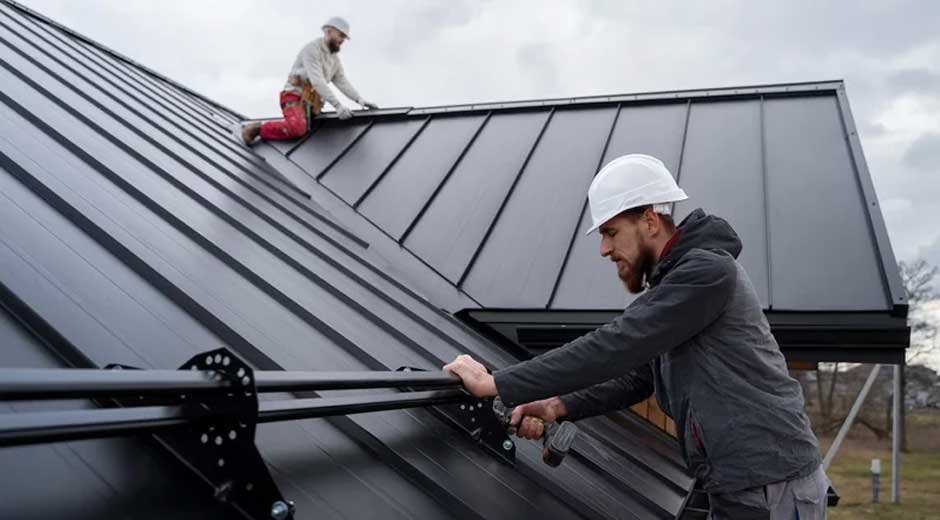Metal roofs have become popular for homeowners and property managers due to their long lifespan, energy efficiency, and sleek appearance. Unlike traditional asphalt shingles, metal roofing systems demand a more detailed installation and a specific approach to maintenance to ensure lasting performance. A roofing contractor is vital in this process, from the initial planning to long-term upkeep. We will explore how contractors guide the installation of metal roofs, ensure their durability over time, and help homeowners make the most of this durable and low-maintenance roofing option.
Role of contractors in the installation of metal roofs
-
Planning and Preparation: The Foundation of a Successful Metal Roof Installation
Before a single panel is installed, the roofing contractor begins with a thorough evaluation of the structure and discusses the property owner’s needs. Planning is essential because it determines the type of metal roof to use—whether it’s standing seam, corrugated, or another style. Each format comes with its installation method and design considerations. The contractor assesses the roof pitch, examines the condition of the existing roof decking, and identifies potential obstacles such as chimneys, skylights, or HVAC components that need to be worked around. In some cases, an old roof must be removed; in others, metal panels can be installed over an existing surface with proper underlayment.
Once the design is confirmed, the contractor from Roof Monster takes precise measurements to ensure materials are ordered correctly, minimizing waste and delays. Attention to detail at this stage is key because metal panels are typically pre-cut and formed based on site specifications. The contractor evaluates ventilation systems and ensures the structure allows adequate airflow beneath the metal roof to prevent moisture buildup. These planning steps also involve a conversation about insulation, fasteners, sealants, and flashing details—all of which contribute to the roof’s overall performance. A well-executed plan provides the contractor with a clear path forward and sets the tone for a smooth, efficient installation.
-
The Installation Process: Precision and Performance in Every Step
Installing a metal roof requires precision, care, and a strong understanding of how different components interact. A roofing contractor begins by preparing the roof surface with an appropriate underlayment, which serves as a moisture barrier and adds another layer of protection beneath the metal panels. Depending on the climate and building needs, the contractor might use synthetic underlayment or high-temperature ice and water shields in vulnerable areas such as valleys and eaves. Once the underlayment is in place, the metal panels are positioned and secured in a sequence that ensures overlap and water runoff are optimized. Contractors use fasteners and clips specifically designed for metal roofing systems, carefully spacing them to allow for thermal expansion without causing damage to the panels.
Improper spacing can lead to oil canning, panel warping, or noisy contraction and expansion in different weather conditions. Flashing is installed around chimneys, vents, and roof edges to direct water away from seams and joints. Contractors also install ridge caps and trim pieces to complete the look while sealing the roof from wind and moisture. Every detail, from panel alignment to the placement of sealants, contributes to the effectiveness of the final roof. Precision in installation not only affects performance but also impacts the overall appearance. Clean lines, tight seams, and uniform fasteners help maintain the visual appeal of a metal roof, which is often chosen as much for its sleek appearance as for its durability. The contractor’s role during installation extends beyond the physical work—they also monitor weather conditions, manage safety on the job site, and communicate with the property owner to ensure expectations are met throughout the process.
-
Ongoing Maintenance and Inspection: Keeping a Metal Roof in Top Shape
Although metal roofs are known for their durability and minimal maintenance needs, they are not entirely maintenance-free. A roofing contractor plays an ongoing role in protecting the roof’s performance through regular inspections and minor upkeep. Over time, weather exposure, debris buildup, and natural wear can affect certain roof parts. Fasteners may loosen, sealants may degrade, or panels may show signs of corrosion if exposed to standing water. Contractors help identify and address these issues early before they lead to more significant problems. A routine inspection typically involves checking all fasteners and connections, assessing the flashing condition, and clearing debris from gutters and valleys. Metal roofs can also be affected by tree branches scraping against the surface or falling debris during storms.
Contractors may recommend trimming nearby branches and can repair minor cosmetic damage, such as scratches or dents that could eventually compromise the protective coating. A critical part of maintenance is checking for water intrusion. While metal is highly water-resistant, any breach in the seams, flashing, or fastener points can create a path for leaks. Contractors use infrared technology or moisture detection tools to locate areas of concern and apply sealants or make repairs as needed. Regular cleaning may also be recommended to remove dirt, algae, or mildew that can build up over time—especially in shaded or humid environments. Contractors advise homeowners on appropriate cleaning methods and materials that won’t damage the roof’s finish, helping preserve performance and appearance over time.
-
Upgrades, Repairs, and Seasonal Support
In addition to inspections and routine maintenance, a roofing contractor supports the long-term value of a metal roof through timely repairs and seasonal services. For example, heavy snow accumulation can strain the structure in colder climates. A contractor can install snow guards or recommend other preventative solutions that reduce the risk of sudden snow slides or ice dams. These upgrades are significant for metal roofs, which allow snow to slide off more efficiently than traditional materials. Over the years, the contractor may replace worn sealants or upgrade fasteners to newer options designed for improved performance. If a panel becomes damaged from weather or impact, a contractor can remove and replace it without altering large roof sections.
This ability to make targeted repairs extends the roof’s lifespan and keeps costs manageable for the homeowner. Contractors also stay updated on new products and installation techniques, allowing them to offer guidance when homeowners consider additions such as skylights, solar panels, or rooftop ventilation systems. These upgrades often require modifications to the roof and must be done in a way that preserves the waterproofing and structural integrity of the metal system. By having an ongoing relationship with the original contractor or a trusted roofing professional, homeowners ensure that any future changes are made with knowledge of the roof’s original design and performance goals. This continuity helps avoid compatibility issues and maintains the long-term value of the investment.
Metal roofs deliver strength, longevity, and modern curb appeal—but achieving those benefits requires thoughtful installation and long-term attention. From preparing the structure and selecting the right materials to completing precise installation and offering seasonal maintenance, roofing contractors play a key role in ensuring every metal roof performs at its full potential. By working closely with a contractor who understands the unique demands of metal roofing, property owners gain peace of mind that their investment is protected. A well-installed and adequately maintained metal roof doesn’t just shield the home from the elements—it adds lasting value, energy savings, and visual appeal for years to come.







